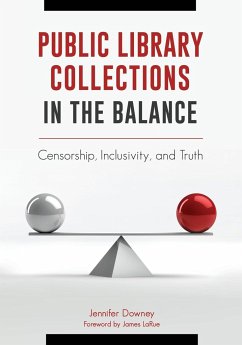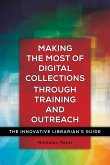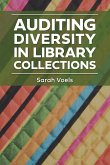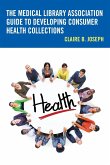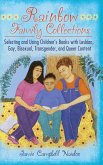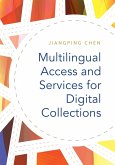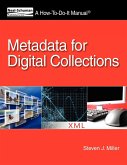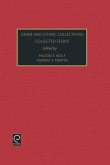- Broschiertes Buch
- Merkliste
- Auf die Merkliste
- Bewerten Bewerten
- Teilen
- Produkt teilen
- Produkterinnerung
- Produkterinnerung
A fascinating and informative read for librarians, library staff, and MLIS students, this book offers practical information and professional guidelines to examine current issues in censorship and libraries while also enabling readers to consider their own opinions about intellectual freedom. This book addresses contemporary issues in censorship and intellectual freedom and can serve as an invaluable resource for librarians and other library staff and as an eye-opening read for MLIS students. It covers the waterfront of intricate and thorny issues regarding intellectual freedom, including…mehr
Andere Kunden interessierten sich auch für
![Making the Most of Digital Collections through Training and Outreach Making the Most of Digital Collections through Training and Outreach]() Nicholas TanziMaking the Most of Digital Collections through Training and Outreach55,99 €
Nicholas TanziMaking the Most of Digital Collections through Training and Outreach55,99 €![Auditing Diversity in Library Collections Auditing Diversity in Library Collections]() Sarah VoelsAuditing Diversity in Library Collections62,99 €
Sarah VoelsAuditing Diversity in Library Collections62,99 €![The Medical Library Association Guide to Developing Consumer Health Collections The Medical Library Association Guide to Developing Consumer Health Collections]() Claire B. JosephThe Medical Library Association Guide to Developing Consumer Health Collections46,99 €
Claire B. JosephThe Medical Library Association Guide to Developing Consumer Health Collections46,99 €![Rainbow Family Collections Rainbow Family Collections]() Jamie Campbell NaidooRainbow Family Collections68,99 €
Jamie Campbell NaidooRainbow Family Collections68,99 €![Multilingual Access and Services for Digital Collections Multilingual Access and Services for Digital Collections]() Jiangping ChenMultilingual Access and Services for Digital Collections75,99 €
Jiangping ChenMultilingual Access and Services for Digital Collections75,99 €![Metadata for Digital Collections Metadata for Digital Collections]() Steven J. MillerMetadata for Digital Collections91,99 €
Steven J. MillerMetadata for Digital Collections91,99 €![Genre and Ethnic Collections Genre and Ethnic Collections]() Genre and Ethnic Collections300,99 €
Genre and Ethnic Collections300,99 €-
-
-
A fascinating and informative read for librarians, library staff, and MLIS students, this book offers practical information and professional guidelines to examine current issues in censorship and libraries while also enabling readers to consider their own opinions about intellectual freedom. This book addresses contemporary issues in censorship and intellectual freedom and can serve as an invaluable resource for librarians and other library staff and as an eye-opening read for MLIS students. It covers the waterfront of intricate and thorny issues regarding intellectual freedom, including determining strategies for patron privacy, deciding how to filter public computers, handling challenges to items in a collection, and recognizing and eliminating under-the-radar self-censorship during collection development and weeding. Readers will also gain an understanding of the perils of over-reliance on community assessments and other evaluative tools and consider important concerns of public library employees, such as whether to restrict borrowing privileges of R-rated movies and M-rated video games to patrons of various ages, and the legalities that surround these questions. Each chapter blends instructive background narrative with practical advice, research findings, and relevant information about librarianship's professional guidelines, including the ALA's Library Bill of Rights and the Freedom to Read Statement. Vignettes, "what would you do?" examples, effective nonconfrontational techniques for conflict resolution, and lists of tips and traps help readers to think critically about their own biases and rehearse possible responses to controversial situations. Librarians, library staff, and MLIS students can use this book for personal professional development, as supplemental reading for MLIS courses or professional training workshops, or as a resource for library policy-planning discussions.
Produktdetails
- Produktdetails
- Verlag: Libraries Unlimited
- Seitenzahl: 224
- Erscheinungstermin: 31. Juli 2017
- Englisch
- Abmessung: 254mm x 178mm x 12mm
- Gewicht: 431g
- ISBN-13: 9781440849640
- ISBN-10: 1440849641
- Artikelnr.: 47710328
- Herstellerkennzeichnung
- Libri GmbH
- Europaallee 1
- 36244 Bad Hersfeld
- gpsr@libri.de
- Verlag: Libraries Unlimited
- Seitenzahl: 224
- Erscheinungstermin: 31. Juli 2017
- Englisch
- Abmessung: 254mm x 178mm x 12mm
- Gewicht: 431g
- ISBN-13: 9781440849640
- ISBN-10: 1440849641
- Artikelnr.: 47710328
- Herstellerkennzeichnung
- Libri GmbH
- Europaallee 1
- 36244 Bad Hersfeld
- gpsr@libri.de
Jennifer Downey, MLIS, is reference librarian at Rancho Cucamonga Public Library.
At first glance, librarianship appears to be more democratic, socially
responsible, and egalitarian than most professions. After all, a quick Web
search reveals that the American Library Association (ALA) boasts its own
Bill of Rights (), an office dedicated to the preservation and defense of
intellectual freedom (), and a progressive-minded round table group that
works in support of social responsibilities such as equity of access,
economic parity, and human rights issues (). Librarians do indeed work hard
and sacrifice greatly in defense of intellectual freedom and the fight
against censorship, and due credit should be given to those who make these
efforts.
As of this writing, the ALA has accredited 59 graduate schools of library
and information science throughout the United States and Canada (). In
addition to the LIS master's degree, many also offer doctorial level
studies. Distance learning is becoming a common option among these
universities as well.
One might assume, given the democratic and socially responsible nature of
librarianship and the small yet substantial number of universities where a
LIS graduate degree may be obtained that an education in library and
information science would include a good deal of study in the areas of
intellectual freedom, censorship, equity, and diversity. And one might be
correct, depending on what school is chosen and what electives are
selected. On the other hand, depending on these same circumstances, one
might be considerably mistaken.
Fewer than half of the 59 LIS graduate programs accredited by the ALA offer
any courses at all in intellectual freedom, censorship, or ethics of
librarianship. Those universities that do have courses on these topics
almost always categorize them as electives. Some universities offer the
courses regularly in the schedule so students have a chance to work them
into their schedules should they choose to do so; but at other
institutions, it can take up to two years for even one to come around.
PURPOSE OF THIS BOOKThe purpose of this book is fill in the gaps left in
library education and to help spark the idea that censorship and
intellectual freedom are important topics that should be more prevalent in
LIS education. Whether as a professional reading, a textbook or as
supplemental reading, librarians and students can use this book to examine
both the professional guidelines of librarianship and their own personal
feelings about topics that can be difficult to think about.
The main reason this book was written was to encourage readers to think
about issues that are not always easy to think about and to be prepared for
the inevitable. The objective is not to change minds but to open them.
Whether it serves as required or supplemental reading for LIS coursework or
as professional reading for anyone who works in public libraries or simply
cares about their role in society, it is hoped that this book offers new
insight and challenges readers to explore delicate topics with open and
curious minds.
SCOPE OF THIS BOOKThis book deals primarily with issues that arise in
public libraries. Because partnerships and collaborations between different
types of libraries is a growing phenomenon, there is some mention of
school, academic, and other types of libraries, but public library
collections are the core of what is addressed. It should be mentioned here
that school libraries bear a larger burden when it comes to community
challenges to materials than do public libraries. As noted in Chapter 7,
partnerships between public libraries and school libraries are becoming
more and more common, as school libraries often have more limits on
collecting than do public libraries. These partnerships provide a chance
for public libraries to offer children and teens in a community the books
they desire without school librarians having to take unnecessary risks of
offending parents and administrators. Therefore, school librarians may
benefit from this book as well.
While an exploration of censorship and intellectual freedom issues in
libraries across both time and the globe would be fascinating in its
complexity, this book deals with American libraries. That said, the ALA is
closely affiliated with the Canadian Library Association, and libraries in
these two countries are quite similar in both purpose and intent (). For
that reason, it is anticipated that those involved with Canadian public
libraries could benefit from this book as well.
After an exploration of the history of censorship in American libraries,
common intellectual freedom and censorship concerns such as the filtering
of public computers, the benefits and perils of community assessments, and
questions of quality and demand in collection development are examined. In
addition, the ins and outs of community challenges are explored in depth
throughout the book-from examining what types of elements make a book or
other item susceptible to being challenged to the writing of strong
policies and the training of staff in order to prevent or quell challenges
to what steps to take when a challenge does occur or get out of control.
Only the most fortunate of librarians will never have to speak with irate
patrons about books or other items that are seen as offensive. For those
who have not yet dealt with such situations, it is hoped that this advice
will be useful when it is needed. For those who have been there and done
that, it is hoped that new skills or at least the comfort of solitarily
will come in handy the next time around.
There are two appendices in this book. One contains a source list of
lesbian, gay, bisexual, and transgender (LGBT) resources for librarians to
use in collection development. The other offers a list of small and
alternative presses, also to assist in collection development. Because
LGBT-themed books are uniquely vulnerable to censorship from both the
public and from librarians themselves, it was deemed important to include
resources for this demographic, as they seldom turn up in mainstream review
sources. The same goes for small and alternative presses. In building
comprehensive, well-rounded collections, librarians need as many places to
turn as possible.
INTENDED AUDIENCEWhile this book is chiefly intended for professionals in
public librarianship and those studying to work in public libraries, it may
also be used in training activities for librarians, library support staff,
trustees, and stakeholders. Libraries often respond to the surprise and
unpleasantness of a challenge by providing training and support and by
changing policies in order to fill in whatever gaps were missing that could
have helped tame the challenge more effectively. In cases like these,
librarians and library managers can turn to this book for guidance and
support.
Hopefully, this book will appeal to librarians and their allies in all
stages of life and career-from the young student exploring ideas of
intellectual freedom for the first time to the retiree volunteering at the
local public library and wanting to learn more about the issues at the root
of the profession.
Finally, those who issue challenges to materials at their public libraries
may benefit, directly or indirectly, from this book. Challenges, despite
the turmoil they create among library staff, are almost always the result
of good intentions: the protection of children, the betterment of the
community, the sanctity of great literature. This is not an
"us-versus-them" book. Although challengers and librarians are so often at
odds, this book aims to help readers understand that the two camps have
more in common than they might know.
HOW TO USE THIS BOOKThis is not a "do this, don't do that" manual. While
professional guidelines are in place to help librarians navigate delicate
situations involving censorship and intellectual freedom, these are not
simplistic subjects and there are no easy answers. When situations that
involve these topics arise, they are almost guaranteed to be taxing,
confusing, and even divisive.
Censorship, especially, is a topic that brings up difficult questions with
no obvious right-or-wrong answers. It's probably fair to assume that most
librarians would agree with the simple statement that censorship isn't a
good thing, but what one person sees as absolutely right is very often seen
by another as absolutely wrong. Throw in technology, children's rights,
parents' concerns, and societal expectations of what the public library's
role is, and you've got so many differences of opinion that coming to any
kind of consensus would be not only a misguided endeavor but an impossible
one.
Perhaps, reading this book will change your mind about some of your
convictions, and perhaps it won't-but a conviction that hasn't been
examined is really just a bias. It is through the examination of previously
held notions of what is good and what is bad that people come to learn what
they truly believe. It's a difficult process and not a particularly
comfortable one, but, hopefully, coming out wiser and stronger in the end
makes it worth the struggle. With this in mind, it is recommended that this
book, especially the vignettes and "what would you do" questions be
carefully explored with open minds and a commitment to critical thought.
All in all, it is hoped that reading this book will raise important
questions and help guide the way to finding the answers. What those answers
may be is entirely up to you.
REFERENCESAmerican Library Association. (2006a, June 30). Library Bill of
Rights. Retrieved from .
American Library Association. (2006b, August 3). Alphabetical List of
Institutions with ALA-Accredited Programs. Retrieved from .
American Library Association. (2007, April 19). Canadian Library
Association. Retrieved from .
American Library Association. (2008, June 9). Office for Intellectual
Freedom. Retrieved from .
American Library Association. (2012, February 22). Social Responsibilities
Round Table. Retrieved from .
responsible, and egalitarian than most professions. After all, a quick Web
search reveals that the American Library Association (ALA) boasts its own
Bill of Rights (), an office dedicated to the preservation and defense of
intellectual freedom (), and a progressive-minded round table group that
works in support of social responsibilities such as equity of access,
economic parity, and human rights issues (). Librarians do indeed work hard
and sacrifice greatly in defense of intellectual freedom and the fight
against censorship, and due credit should be given to those who make these
efforts.
As of this writing, the ALA has accredited 59 graduate schools of library
and information science throughout the United States and Canada (). In
addition to the LIS master's degree, many also offer doctorial level
studies. Distance learning is becoming a common option among these
universities as well.
One might assume, given the democratic and socially responsible nature of
librarianship and the small yet substantial number of universities where a
LIS graduate degree may be obtained that an education in library and
information science would include a good deal of study in the areas of
intellectual freedom, censorship, equity, and diversity. And one might be
correct, depending on what school is chosen and what electives are
selected. On the other hand, depending on these same circumstances, one
might be considerably mistaken.
Fewer than half of the 59 LIS graduate programs accredited by the ALA offer
any courses at all in intellectual freedom, censorship, or ethics of
librarianship. Those universities that do have courses on these topics
almost always categorize them as electives. Some universities offer the
courses regularly in the schedule so students have a chance to work them
into their schedules should they choose to do so; but at other
institutions, it can take up to two years for even one to come around.
PURPOSE OF THIS BOOKThe purpose of this book is fill in the gaps left in
library education and to help spark the idea that censorship and
intellectual freedom are important topics that should be more prevalent in
LIS education. Whether as a professional reading, a textbook or as
supplemental reading, librarians and students can use this book to examine
both the professional guidelines of librarianship and their own personal
feelings about topics that can be difficult to think about.
The main reason this book was written was to encourage readers to think
about issues that are not always easy to think about and to be prepared for
the inevitable. The objective is not to change minds but to open them.
Whether it serves as required or supplemental reading for LIS coursework or
as professional reading for anyone who works in public libraries or simply
cares about their role in society, it is hoped that this book offers new
insight and challenges readers to explore delicate topics with open and
curious minds.
SCOPE OF THIS BOOKThis book deals primarily with issues that arise in
public libraries. Because partnerships and collaborations between different
types of libraries is a growing phenomenon, there is some mention of
school, academic, and other types of libraries, but public library
collections are the core of what is addressed. It should be mentioned here
that school libraries bear a larger burden when it comes to community
challenges to materials than do public libraries. As noted in Chapter 7,
partnerships between public libraries and school libraries are becoming
more and more common, as school libraries often have more limits on
collecting than do public libraries. These partnerships provide a chance
for public libraries to offer children and teens in a community the books
they desire without school librarians having to take unnecessary risks of
offending parents and administrators. Therefore, school librarians may
benefit from this book as well.
While an exploration of censorship and intellectual freedom issues in
libraries across both time and the globe would be fascinating in its
complexity, this book deals with American libraries. That said, the ALA is
closely affiliated with the Canadian Library Association, and libraries in
these two countries are quite similar in both purpose and intent (). For
that reason, it is anticipated that those involved with Canadian public
libraries could benefit from this book as well.
After an exploration of the history of censorship in American libraries,
common intellectual freedom and censorship concerns such as the filtering
of public computers, the benefits and perils of community assessments, and
questions of quality and demand in collection development are examined. In
addition, the ins and outs of community challenges are explored in depth
throughout the book-from examining what types of elements make a book or
other item susceptible to being challenged to the writing of strong
policies and the training of staff in order to prevent or quell challenges
to what steps to take when a challenge does occur or get out of control.
Only the most fortunate of librarians will never have to speak with irate
patrons about books or other items that are seen as offensive. For those
who have not yet dealt with such situations, it is hoped that this advice
will be useful when it is needed. For those who have been there and done
that, it is hoped that new skills or at least the comfort of solitarily
will come in handy the next time around.
There are two appendices in this book. One contains a source list of
lesbian, gay, bisexual, and transgender (LGBT) resources for librarians to
use in collection development. The other offers a list of small and
alternative presses, also to assist in collection development. Because
LGBT-themed books are uniquely vulnerable to censorship from both the
public and from librarians themselves, it was deemed important to include
resources for this demographic, as they seldom turn up in mainstream review
sources. The same goes for small and alternative presses. In building
comprehensive, well-rounded collections, librarians need as many places to
turn as possible.
INTENDED AUDIENCEWhile this book is chiefly intended for professionals in
public librarianship and those studying to work in public libraries, it may
also be used in training activities for librarians, library support staff,
trustees, and stakeholders. Libraries often respond to the surprise and
unpleasantness of a challenge by providing training and support and by
changing policies in order to fill in whatever gaps were missing that could
have helped tame the challenge more effectively. In cases like these,
librarians and library managers can turn to this book for guidance and
support.
Hopefully, this book will appeal to librarians and their allies in all
stages of life and career-from the young student exploring ideas of
intellectual freedom for the first time to the retiree volunteering at the
local public library and wanting to learn more about the issues at the root
of the profession.
Finally, those who issue challenges to materials at their public libraries
may benefit, directly or indirectly, from this book. Challenges, despite
the turmoil they create among library staff, are almost always the result
of good intentions: the protection of children, the betterment of the
community, the sanctity of great literature. This is not an
"us-versus-them" book. Although challengers and librarians are so often at
odds, this book aims to help readers understand that the two camps have
more in common than they might know.
HOW TO USE THIS BOOKThis is not a "do this, don't do that" manual. While
professional guidelines are in place to help librarians navigate delicate
situations involving censorship and intellectual freedom, these are not
simplistic subjects and there are no easy answers. When situations that
involve these topics arise, they are almost guaranteed to be taxing,
confusing, and even divisive.
Censorship, especially, is a topic that brings up difficult questions with
no obvious right-or-wrong answers. It's probably fair to assume that most
librarians would agree with the simple statement that censorship isn't a
good thing, but what one person sees as absolutely right is very often seen
by another as absolutely wrong. Throw in technology, children's rights,
parents' concerns, and societal expectations of what the public library's
role is, and you've got so many differences of opinion that coming to any
kind of consensus would be not only a misguided endeavor but an impossible
one.
Perhaps, reading this book will change your mind about some of your
convictions, and perhaps it won't-but a conviction that hasn't been
examined is really just a bias. It is through the examination of previously
held notions of what is good and what is bad that people come to learn what
they truly believe. It's a difficult process and not a particularly
comfortable one, but, hopefully, coming out wiser and stronger in the end
makes it worth the struggle. With this in mind, it is recommended that this
book, especially the vignettes and "what would you do" questions be
carefully explored with open minds and a commitment to critical thought.
All in all, it is hoped that reading this book will raise important
questions and help guide the way to finding the answers. What those answers
may be is entirely up to you.
REFERENCESAmerican Library Association. (2006a, June 30). Library Bill of
Rights. Retrieved from .
American Library Association. (2006b, August 3). Alphabetical List of
Institutions with ALA-Accredited Programs. Retrieved from .
American Library Association. (2007, April 19). Canadian Library
Association. Retrieved from .
American Library Association. (2008, June 9). Office for Intellectual
Freedom. Retrieved from .
American Library Association. (2012, February 22). Social Responsibilities
Round Table. Retrieved from .
At first glance, librarianship appears to be more democratic, socially
responsible, and egalitarian than most professions. After all, a quick Web
search reveals that the American Library Association (ALA) boasts its own
Bill of Rights (), an office dedicated to the preservation and defense of
intellectual freedom (), and a progressive-minded round table group that
works in support of social responsibilities such as equity of access,
economic parity, and human rights issues (). Librarians do indeed work hard
and sacrifice greatly in defense of intellectual freedom and the fight
against censorship, and due credit should be given to those who make these
efforts.
As of this writing, the ALA has accredited 59 graduate schools of library
and information science throughout the United States and Canada (). In
addition to the LIS master's degree, many also offer doctorial level
studies. Distance learning is becoming a common option among these
universities as well.
One might assume, given the democratic and socially responsible nature of
librarianship and the small yet substantial number of universities where a
LIS graduate degree may be obtained that an education in library and
information science would include a good deal of study in the areas of
intellectual freedom, censorship, equity, and diversity. And one might be
correct, depending on what school is chosen and what electives are
selected. On the other hand, depending on these same circumstances, one
might be considerably mistaken.
Fewer than half of the 59 LIS graduate programs accredited by the ALA offer
any courses at all in intellectual freedom, censorship, or ethics of
librarianship. Those universities that do have courses on these topics
almost always categorize them as electives. Some universities offer the
courses regularly in the schedule so students have a chance to work them
into their schedules should they choose to do so; but at other
institutions, it can take up to two years for even one to come around.
PURPOSE OF THIS BOOKThe purpose of this book is fill in the gaps left in
library education and to help spark the idea that censorship and
intellectual freedom are important topics that should be more prevalent in
LIS education. Whether as a professional reading, a textbook or as
supplemental reading, librarians and students can use this book to examine
both the professional guidelines of librarianship and their own personal
feelings about topics that can be difficult to think about.
The main reason this book was written was to encourage readers to think
about issues that are not always easy to think about and to be prepared for
the inevitable. The objective is not to change minds but to open them.
Whether it serves as required or supplemental reading for LIS coursework or
as professional reading for anyone who works in public libraries or simply
cares about their role in society, it is hoped that this book offers new
insight and challenges readers to explore delicate topics with open and
curious minds.
SCOPE OF THIS BOOKThis book deals primarily with issues that arise in
public libraries. Because partnerships and collaborations between different
types of libraries is a growing phenomenon, there is some mention of
school, academic, and other types of libraries, but public library
collections are the core of what is addressed. It should be mentioned here
that school libraries bear a larger burden when it comes to community
challenges to materials than do public libraries. As noted in Chapter 7,
partnerships between public libraries and school libraries are becoming
more and more common, as school libraries often have more limits on
collecting than do public libraries. These partnerships provide a chance
for public libraries to offer children and teens in a community the books
they desire without school librarians having to take unnecessary risks of
offending parents and administrators. Therefore, school librarians may
benefit from this book as well.
While an exploration of censorship and intellectual freedom issues in
libraries across both time and the globe would be fascinating in its
complexity, this book deals with American libraries. That said, the ALA is
closely affiliated with the Canadian Library Association, and libraries in
these two countries are quite similar in both purpose and intent (). For
that reason, it is anticipated that those involved with Canadian public
libraries could benefit from this book as well.
After an exploration of the history of censorship in American libraries,
common intellectual freedom and censorship concerns such as the filtering
of public computers, the benefits and perils of community assessments, and
questions of quality and demand in collection development are examined. In
addition, the ins and outs of community challenges are explored in depth
throughout the book-from examining what types of elements make a book or
other item susceptible to being challenged to the writing of strong
policies and the training of staff in order to prevent or quell challenges
to what steps to take when a challenge does occur or get out of control.
Only the most fortunate of librarians will never have to speak with irate
patrons about books or other items that are seen as offensive. For those
who have not yet dealt with such situations, it is hoped that this advice
will be useful when it is needed. For those who have been there and done
that, it is hoped that new skills or at least the comfort of solitarily
will come in handy the next time around.
There are two appendices in this book. One contains a source list of
lesbian, gay, bisexual, and transgender (LGBT) resources for librarians to
use in collection development. The other offers a list of small and
alternative presses, also to assist in collection development. Because
LGBT-themed books are uniquely vulnerable to censorship from both the
public and from librarians themselves, it was deemed important to include
resources for this demographic, as they seldom turn up in mainstream review
sources. The same goes for small and alternative presses. In building
comprehensive, well-rounded collections, librarians need as many places to
turn as possible.
INTENDED AUDIENCEWhile this book is chiefly intended for professionals in
public librarianship and those studying to work in public libraries, it may
also be used in training activities for librarians, library support staff,
trustees, and stakeholders. Libraries often respond to the surprise and
unpleasantness of a challenge by providing training and support and by
changing policies in order to fill in whatever gaps were missing that could
have helped tame the challenge more effectively. In cases like these,
librarians and library managers can turn to this book for guidance and
support.
Hopefully, this book will appeal to librarians and their allies in all
stages of life and career-from the young student exploring ideas of
intellectual freedom for the first time to the retiree volunteering at the
local public library and wanting to learn more about the issues at the root
of the profession.
Finally, those who issue challenges to materials at their public libraries
may benefit, directly or indirectly, from this book. Challenges, despite
the turmoil they create among library staff, are almost always the result
of good intentions: the protection of children, the betterment of the
community, the sanctity of great literature. This is not an
"us-versus-them" book. Although challengers and librarians are so often at
odds, this book aims to help readers understand that the two camps have
more in common than they might know.
HOW TO USE THIS BOOKThis is not a "do this, don't do that" manual. While
professional guidelines are in place to help librarians navigate delicate
situations involving censorship and intellectual freedom, these are not
simplistic subjects and there are no easy answers. When situations that
involve these topics arise, they are almost guaranteed to be taxing,
confusing, and even divisive.
Censorship, especially, is a topic that brings up difficult questions with
no obvious right-or-wrong answers. It's probably fair to assume that most
librarians would agree with the simple statement that censorship isn't a
good thing, but what one person sees as absolutely right is very often seen
by another as absolutely wrong. Throw in technology, children's rights,
parents' concerns, and societal expectations of what the public library's
role is, and you've got so many differences of opinion that coming to any
kind of consensus would be not only a misguided endeavor but an impossible
one.
Perhaps, reading this book will change your mind about some of your
convictions, and perhaps it won't-but a conviction that hasn't been
examined is really just a bias. It is through the examination of previously
held notions of what is good and what is bad that people come to learn what
they truly believe. It's a difficult process and not a particularly
comfortable one, but, hopefully, coming out wiser and stronger in the end
makes it worth the struggle. With this in mind, it is recommended that this
book, especially the vignettes and "what would you do" questions be
carefully explored with open minds and a commitment to critical thought.
All in all, it is hoped that reading this book will raise important
questions and help guide the way to finding the answers. What those answers
may be is entirely up to you.
REFERENCESAmerican Library Association. (2006a, June 30). Library Bill of
Rights. Retrieved from .
American Library Association. (2006b, August 3). Alphabetical List of
Institutions with ALA-Accredited Programs. Retrieved from .
American Library Association. (2007, April 19). Canadian Library
Association. Retrieved from .
American Library Association. (2008, June 9). Office for Intellectual
Freedom. Retrieved from .
American Library Association. (2012, February 22). Social Responsibilities
Round Table. Retrieved from .
responsible, and egalitarian than most professions. After all, a quick Web
search reveals that the American Library Association (ALA) boasts its own
Bill of Rights (), an office dedicated to the preservation and defense of
intellectual freedom (), and a progressive-minded round table group that
works in support of social responsibilities such as equity of access,
economic parity, and human rights issues (). Librarians do indeed work hard
and sacrifice greatly in defense of intellectual freedom and the fight
against censorship, and due credit should be given to those who make these
efforts.
As of this writing, the ALA has accredited 59 graduate schools of library
and information science throughout the United States and Canada (). In
addition to the LIS master's degree, many also offer doctorial level
studies. Distance learning is becoming a common option among these
universities as well.
One might assume, given the democratic and socially responsible nature of
librarianship and the small yet substantial number of universities where a
LIS graduate degree may be obtained that an education in library and
information science would include a good deal of study in the areas of
intellectual freedom, censorship, equity, and diversity. And one might be
correct, depending on what school is chosen and what electives are
selected. On the other hand, depending on these same circumstances, one
might be considerably mistaken.
Fewer than half of the 59 LIS graduate programs accredited by the ALA offer
any courses at all in intellectual freedom, censorship, or ethics of
librarianship. Those universities that do have courses on these topics
almost always categorize them as electives. Some universities offer the
courses regularly in the schedule so students have a chance to work them
into their schedules should they choose to do so; but at other
institutions, it can take up to two years for even one to come around.
PURPOSE OF THIS BOOKThe purpose of this book is fill in the gaps left in
library education and to help spark the idea that censorship and
intellectual freedom are important topics that should be more prevalent in
LIS education. Whether as a professional reading, a textbook or as
supplemental reading, librarians and students can use this book to examine
both the professional guidelines of librarianship and their own personal
feelings about topics that can be difficult to think about.
The main reason this book was written was to encourage readers to think
about issues that are not always easy to think about and to be prepared for
the inevitable. The objective is not to change minds but to open them.
Whether it serves as required or supplemental reading for LIS coursework or
as professional reading for anyone who works in public libraries or simply
cares about their role in society, it is hoped that this book offers new
insight and challenges readers to explore delicate topics with open and
curious minds.
SCOPE OF THIS BOOKThis book deals primarily with issues that arise in
public libraries. Because partnerships and collaborations between different
types of libraries is a growing phenomenon, there is some mention of
school, academic, and other types of libraries, but public library
collections are the core of what is addressed. It should be mentioned here
that school libraries bear a larger burden when it comes to community
challenges to materials than do public libraries. As noted in Chapter 7,
partnerships between public libraries and school libraries are becoming
more and more common, as school libraries often have more limits on
collecting than do public libraries. These partnerships provide a chance
for public libraries to offer children and teens in a community the books
they desire without school librarians having to take unnecessary risks of
offending parents and administrators. Therefore, school librarians may
benefit from this book as well.
While an exploration of censorship and intellectual freedom issues in
libraries across both time and the globe would be fascinating in its
complexity, this book deals with American libraries. That said, the ALA is
closely affiliated with the Canadian Library Association, and libraries in
these two countries are quite similar in both purpose and intent (). For
that reason, it is anticipated that those involved with Canadian public
libraries could benefit from this book as well.
After an exploration of the history of censorship in American libraries,
common intellectual freedom and censorship concerns such as the filtering
of public computers, the benefits and perils of community assessments, and
questions of quality and demand in collection development are examined. In
addition, the ins and outs of community challenges are explored in depth
throughout the book-from examining what types of elements make a book or
other item susceptible to being challenged to the writing of strong
policies and the training of staff in order to prevent or quell challenges
to what steps to take when a challenge does occur or get out of control.
Only the most fortunate of librarians will never have to speak with irate
patrons about books or other items that are seen as offensive. For those
who have not yet dealt with such situations, it is hoped that this advice
will be useful when it is needed. For those who have been there and done
that, it is hoped that new skills or at least the comfort of solitarily
will come in handy the next time around.
There are two appendices in this book. One contains a source list of
lesbian, gay, bisexual, and transgender (LGBT) resources for librarians to
use in collection development. The other offers a list of small and
alternative presses, also to assist in collection development. Because
LGBT-themed books are uniquely vulnerable to censorship from both the
public and from librarians themselves, it was deemed important to include
resources for this demographic, as they seldom turn up in mainstream review
sources. The same goes for small and alternative presses. In building
comprehensive, well-rounded collections, librarians need as many places to
turn as possible.
INTENDED AUDIENCEWhile this book is chiefly intended for professionals in
public librarianship and those studying to work in public libraries, it may
also be used in training activities for librarians, library support staff,
trustees, and stakeholders. Libraries often respond to the surprise and
unpleasantness of a challenge by providing training and support and by
changing policies in order to fill in whatever gaps were missing that could
have helped tame the challenge more effectively. In cases like these,
librarians and library managers can turn to this book for guidance and
support.
Hopefully, this book will appeal to librarians and their allies in all
stages of life and career-from the young student exploring ideas of
intellectual freedom for the first time to the retiree volunteering at the
local public library and wanting to learn more about the issues at the root
of the profession.
Finally, those who issue challenges to materials at their public libraries
may benefit, directly or indirectly, from this book. Challenges, despite
the turmoil they create among library staff, are almost always the result
of good intentions: the protection of children, the betterment of the
community, the sanctity of great literature. This is not an
"us-versus-them" book. Although challengers and librarians are so often at
odds, this book aims to help readers understand that the two camps have
more in common than they might know.
HOW TO USE THIS BOOKThis is not a "do this, don't do that" manual. While
professional guidelines are in place to help librarians navigate delicate
situations involving censorship and intellectual freedom, these are not
simplistic subjects and there are no easy answers. When situations that
involve these topics arise, they are almost guaranteed to be taxing,
confusing, and even divisive.
Censorship, especially, is a topic that brings up difficult questions with
no obvious right-or-wrong answers. It's probably fair to assume that most
librarians would agree with the simple statement that censorship isn't a
good thing, but what one person sees as absolutely right is very often seen
by another as absolutely wrong. Throw in technology, children's rights,
parents' concerns, and societal expectations of what the public library's
role is, and you've got so many differences of opinion that coming to any
kind of consensus would be not only a misguided endeavor but an impossible
one.
Perhaps, reading this book will change your mind about some of your
convictions, and perhaps it won't-but a conviction that hasn't been
examined is really just a bias. It is through the examination of previously
held notions of what is good and what is bad that people come to learn what
they truly believe. It's a difficult process and not a particularly
comfortable one, but, hopefully, coming out wiser and stronger in the end
makes it worth the struggle. With this in mind, it is recommended that this
book, especially the vignettes and "what would you do" questions be
carefully explored with open minds and a commitment to critical thought.
All in all, it is hoped that reading this book will raise important
questions and help guide the way to finding the answers. What those answers
may be is entirely up to you.
REFERENCESAmerican Library Association. (2006a, June 30). Library Bill of
Rights. Retrieved from .
American Library Association. (2006b, August 3). Alphabetical List of
Institutions with ALA-Accredited Programs. Retrieved from .
American Library Association. (2007, April 19). Canadian Library
Association. Retrieved from .
American Library Association. (2008, June 9). Office for Intellectual
Freedom. Retrieved from .
American Library Association. (2012, February 22). Social Responsibilities
Round Table. Retrieved from .

